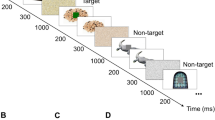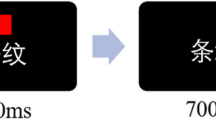Abstract
The attentional boost effect (ABE) and action-induced memory enhancement (AIME) suggest that memory performance for target-paired items is superior to that for distractor-paired items when participants performed a target detection task and a memory encoding task simultaneously. Though the memory enhancement has been well established, the temporal dynamics of how the target detection task influenced memory encoding remains unclear. To investigate this, we manipulated the stimulus onset asynchrony (SOA) between detection stimuli and the words to be memorized using a remember/know study-test paradigm, and we focused primarily on memory performance for the words that appeared after the detection response. The results showed that target-paired memory enhancement was robust from SOA = 0 s to SOA = 0.75 s, but was not significant when examined by itself in Experiment 1A or weakened in Experiment 2 and the conjoint analysis when SOA = 1 s, which were only observed in R responses. The post-response memory enhancement still existed when there was no temporal overlap between the word and target, similar to the magnitude of memory enhancement observed with temporal overlap. These results supported the view that target-paired memory enhancement (recollection rather than familiarity) occurred irrespective of whether the items appeared simultaneously with the targets or within a short period after the response, and the temporal overlap of the word and target was not necessary for post-response memory enhancement.




Similar content being viewed by others
Notes
The reported p-value was for a one-tailed test, whereas the p-value for a two-tailed test was 0.065.
References
Andres, M., Seron, X., & Olivier, E. (2007). Contribution of hand motor circuits to counting. Journal of Cognitive Neuroscience, 19(4), 563–576. https://doi.org/10.1162/jocn.2007.19.4.563
Aston-Jones, G., & Cohen, J. D. (2005). An integrative theory of locus coeruleus-norepinephrine Function: Adaptive gain and optimal performance. Annual Review of Neuroscience, 28(1), 403–450. https://doi.org/10.1146/annurev.neuro.28.061604.135709
Aston-Jones, G., Rajkowski, J., Kubiak, P., & Alexinsky, T. (1994). Locus coeruleus neurons in monkey are selectively activated by attended cues in a vigilance task. The Journal of Neuroscience: The Official Journal of the Society for Neuroscience, 14(7), 4467–4480. https://doi.org/10.1523/JNEUROSCI.14-07-04467.1994
Broitman, A. W., & Swallow, K. M. (2019). The Effects of encoding Instruction and opportunity on the recollection of behaviorally relevant events. Quarterly Journal of Experimental Psychology, 73(5), 174702181989367. https://doi.org/10.1177/1747021819893676
Clayton, E. C., Rajkowski, J., Cohen, J. D., & Aston-Jones, G. (2004). Phasic activation of monkey locus ceruleus neurons by simple decisions in a forced-choice task. The Journal of Neuroscience, 24(44), 9914–9920. https://doi.org/10.1523/JNEUROSCI.2446-04.2004
Dunn, J. C. (2004). Remember-know: A matter of confidence. Psychological Review, 111(2), 524. https://doi.org/10.1037/0033-295X.111.2.524
Eldridge, L. L., Sarfatti, S., & Knowlton, B. J. (2002). The effect of testing procedure on remember-know judgments. Psychonomic Bulletin & Review, 9(1), 139–145. https://doi.org/10.3758/BF03196270
Gardiner, J. M., Ramponi, C., & Richardson-Klavehn, A. (2002). Recognition memory and decision processes: A meta-analysis of remember, know, and guess responses. Memory, 10(2), 83–98. https://doi.org/10.1080/09658210143000281
Han, M., Mao, X., Kartvelishvili, N., Li, W., & Guo, C. (2018). Unitization mitigates interference by intrinsic negative emotion in familiarity and recollection of associative memory: Electrophysiological evidence. Cognitive, Affective, & Behavioral Neuroscience, 18(6), 1259–1268. https://doi.org/10.3758/s13415-018-0636-y
Herrmann, M. J., Ehlis, A.-C., Ellgring, H., & Fallgatter, A. J. (2005). Early stages (P100) of face perception in humans as measured with event-related potentials (ERPs). Journal of Neural Transmission, 112(8), 1073–1081. https://doi.org/10.1007/s00702-004-0250-8
Hicks, J. L., & Marsh, R. L. (1999). Remember-know judgments can depend on how memory is tested. Psychonomic Bulletin & Review, 6(1), 117–122. https://doi.org/10.3758/BF03210818
Hoffing, R. C., & Seitz, A. R. (2015). Pupillometry as a glimpse into the neurochemical basis of human memory encoding. Journal of Cognitive Neuroscience, 27(4), 765–774. https://doi.org/10.1162/jocn_a_00749
Hommel, B. (2004). Event files: Feature binding in and across perception and action. Trends in Cognitive Sciences, 8(11), 494–500. https://doi.org/10.1016/j.tics.2004.08.007
Huang, S., & Meng, Y. (2021). The influence of encode intentionality on attentional boost effect a research based on R/K Paradigm. Journal of Psychological Science (Chinese), 44(6), 8. https://doi.org/10.16719/j.cnki.1671-6981.20210604
Imbo, I., Vandierendonck, A., and Fias, W. (2011). Passive hand movements disrupt adults’ counting strategies. Frontiers in Psychology, 2. https://doi.org/10.3389/fpsyg.2011.00201
Jacoby, L. L., Jones, T. C., & Dolan, P. O. (1998). Two effects of repetition: Support for a dual-process model of know judgments and exclusion errors. Psychonomic Bulletin & Review, 5(4), 705–709. https://doi.org/10.3758/BF03208849
Jefferies, L. N., & Di Lollo, V. (2019). Sudden events change old visual objects into new ones: A possible role for phasic activation of locus coeruleus. Psychological Science, 30(1), 55–64. https://doi.org/10.1177/0956797618807190
Kalwani, R. M., Joshi, S., & Gold, J. I. (2014). Phasic activation of individual neurons in the locus ceruleus/subceruleus complex of monkeys reflects rewarded decisions to go but not stop. The Journal of Neuroscience, 34(41), 13656–13669. https://doi.org/10.1523/JNEUROSCI.2566-14.2014
Komar, G. F., Mieth, L., Buchner, A., and Bell, R. (2022). Animacy enhances recollection but not familiarity: Convergent evidence from the remember-know-guess paradigm and the process-dissociation procedure. Memory & Cognition, 1–17. https://doi.org/10.3758/s13421-022-01339-6
Li, A., Yan, L., Wang, X., Ma, X., & Li, F. (2015). The Double-edged Effect and Mechanism of Time Pressure. Advances in Psychological Science (Chinese), 23(9), 1627. https://doi.org/10.3724/SP.J.1042.2015.01627
Liang, N. (2011). Introduction to psychology. Shanghai Education.
Lin, G., Meng, Y., & Lin, H. (2020). An ERP study of attentional boost effect. Journal of Psychological Science (Chinese), 43(1), 9–16. https://doi.org/10.16719/j.cnki.1671-6981.20200102
Makovski, T., Swallow, K. M., & Jiang, Y. V. (2011). Attending to unrelated targets boosts short-term memory for color arrays. Neuropsychologia, 49(6), 1498–1505. https://doi.org/10.1016/j.neuropsychologia.2010.11.029
Martin, E. W., & Shapiro, K. L. (2008). Does failure to mask T1 cause lag-1 sparing in the attentional blink? Perception & Psychophysics, 70, 562–570. https://doi.org/10.3758/PP.70.3.562
Meng, Y., Lin, G., and Lin, H. (2019). The role of distractor inhibition in the attentional boost effect: Evidence from the R/K paradigm. Memory, 27(6). https://doi.org/10.1080/09658211.2018.1563188
Moyal, R., Turker, H. B., Luh, W.-M., & Swallow, K. M. (2022). Auditory target detection enhances visual processing and hippocampal functional connectivity. Frontiers in Psychology, 13(891682), Q1. https://doi.org/10.3389/fpsyg.2022.891682
Mulligan, N. W., Pietro, S., and Milton, P. (2014). The attentional boost effect with verbal materials. Journal of Experimental Psychology: Learning, Memory, and Cognition, 40(4). https://doi.org/10.1037/a0036163
Mulligan, N. W., Smith S. Adam, and Spataro Pietro. (2016). The attentional boost effect and context memory. Journal of Experimental Psychology: Learning, Memory, and Cognition, 42(4). https://doi.org/10.1037/xlm0000183
Nieuwenhuis, S., Gilzenrat, M. S., Holmes, B. D., & Cohen, J. D. (2005). The role of the locus coeruleus in mediating the attentional blink: A neurocomputational theory. Journal of Experimental Psychology: General, 134(3), 291–307. https://doi.org/10.1037/0096-3445.134.3.291
Olivers, C. N. L. (2010). The attentional boost and the attentional blink. In A. C. Nobre & J. T. Coull (Eds.), Attention and Time (1st ed., pp. 49–62). Oxford University PressOxford. https://doi.org/10.1093/acprof:oso/9780199563456.003.0004
Olivers, C. N. L., & Meeter, M. (2008). A boost and bounce theory of temporal attention. Psychological Review, 115(4), 836–863. https://doi.org/10.1037/a0013395
Pashler, H. (1994). Dual-task interference in simple tasks: Data and theory. Psychological Bulletin, 116(2), 220–244. https://doi.org/10.1037/0033-2909.116.2.220
Rice, S., & Trafimow, D. (2012). Time pressure heuristics can improve performance due to increased consistency. The Journal of General Psychology, 139(4), 273–288. https://doi.org/10.1080/00221309.2012.705187
Shimane, D., Tanaka, T., Watanabe, K., and Tanaka, K. (2021). Post-action memory enhancement: Exploring the temporal relationship between action and memory formation. https://osf.io/sq6gk
Shimane, D., Tanaka, T., Watanabe, K., & Tanaka, K. (2022). Motor engagement enhances incidental memory for task-irrelevant items. Frontiers in Psychology, 13, 914877. https://doi.org/10.3389/fpsyg.2022.914877
Spataro, P., Saraulli, D., Cestari, V., Mulligan, N. W., Santirocchi, A., Borowiecki, O., & Rossi-Arnaud, C. (2020). The attentional boost effect enhances the recognition of bound features in short-term memory. Memory, 28(7), 926–937. https://doi.org/10.1080/09658211.2020.1801752
Svenson, O., & Edland, A. (1987). Change of preferences under time pressure: Choices and judgments. Scandinavian Journal of Psychology, 28(4), 322–330. https://doi.org/10.1111/j.1467-9450.1987.tb00769.x
Swallow, K. M., and Jiang, Y. V. (2013). Attentional Load and Attentional Boost: A Review of Data and Theory. Frontiers in Psychology, 4. https://doi.org/10.3389/fpsyg.2013.00274
Swallow, K. M., Jiang, Y. V., and Riley, E. B. (2019). Target detection increases pupil diameter and enhances memory for background scenes during multi-tasking. Scientific Reports, 9(1). https://doi.org/10.1038/s41598-019-41658-4
Swallow, K. M., & Jiang, Y. V. (2010). The attentional boost effect: Transient increases in attention to one task enhance performance in a second task. Cognition, 115(1), 118–132. https://doi.org/10.1016/j.cognition.2009.12.003
Swallow, K. M., & Jiang, Y. V. (2011). The role of timing in the attentional boost effect. Attention, Perception, & Psychophysics, 73(2), 389–404. https://doi.org/10.3758/s13414-010-0045-y
Swallow, K. M., & Jiang, Y. V. (2012). Goal-relevant events need not be rare to boost memory for concurrent images. Attention, Perception, Psychophysics, 74(1), 70–82. https://doi.org/10.3758/s13414-011-0227-2
Swallow, K. M., & Jiang, Y. V. (2014). Perceptual load and attentional boost: A study of their interaction. Journal of Experimental Psychology: Human Perception and Performance, 40(3), 1034–1045. https://doi.org/10.1037/a0035312
Swallow, K. M., & Jiang, Y. V. (2014). The attentional boost effect really is a boost: Evidence from a new baseline. Attention, Perception, & Psychophysics, 76(5), 1298–1307. https://doi.org/10.3758/s13414-014-0677-4
Swallow, K. M., Makovski, T., & Jiang, Y. V. (2012). Selection of events in time enhances activity throughout early visual cortex. Journal of Neurophysiology, 108(12), 3239–3252. https://doi.org/10.1152/jn.00472.2012
Toh, Y. N., & Lee, V. G. (2022). Both target detection and response contribute to the attentional boost effect. Journal of Experimental Psychology: Human Perception and Performance. https://doi.org/10.1037/xhp0001048
Toh, Y. N., & Lee, V. G. (2022). Response, rather than target detection, triggers the attentional boost effect in visual search. Journal of Experimental Psychology: Human Perception Performance, 48(1), 77–93. https://doi.org/10.1037/xhp0000977
Tulving, E. (2002). Episodic Memory: From Mind to Brain. Annual Review of Psychology, 53(1), 1–25. https://doi.org/10.1146/annurev.psych.53.100901.135114
Virsu, V., & Laurinen, P. (1977). Long-lasting afterimages caused by neural adaptation. Vision Research, 17(7), 853–860. https://doi.org/10.1016/0042-6989(77)90129-8
Yebra, M., Galarza-Vallejo, A., Soto-Leon, V., Gonzalez-Rosa, J. J., de Berker, A. O., Bestmann, S., Oliviero, A., Kroes, M. C. W., & Strange, B. A. (2019). Action boosts episodic memory encoding in humans via engagement of a noradrenergic system. Nature Communications, 10(1), 3534. https://doi.org/10.1038/s41467-019-11358-8
Yonelinas, A. P. (2002). The Nature of Recollection and Familiarity: A Review of 30 Years of Research. Journal of Memory and Language, 46(3), 441–517. https://doi.org/10.1006/jmla.2002.2864
Yonelinas, A. P., & Jacoby, L. L. (1995). the relation between remembering and knowing as bases for recognition: Effects of size congruency. Journal of Memory and Language, 34(5), 622–643. https://doi.org/10.1006/jmla.1995.1028
Zheng, S., Meng, Y., & Huang, F. (2022). Target decision or action? The role of action in the attentional boost effect. Acta Psychologica Sinica (Chinese), 54(11), 1325. https://doi.org/10.3724/SP.J.1041.2022.01325
Author information
Authors and Affiliations
Contributions
Chenyang Shang: Writing-original draft, data curation, software, formal analysis.
Meng Sun: Writing – review and editing.
Qin Zhang: Conceptualization, supervision, project administration, funding acquisition.
Corresponding author
Ethics declarations
Conflicts of interest
There are no conflicts of interest.
Additional information
Publisher's Note
Springer Nature remains neutral with regard to jurisdictional claims in published maps and institutional affiliations.
Open Practices Statement
The datasets analyzed are available online (https://osf.io/h5nr8/?view_only=1adf5874c9da4eaa87f044089e7950d3), and none of the experiments was preregistered.
Supplementary Information
Below is the link to the electronic supplementary material.
Rights and permissions
Springer Nature or its licensor (e.g. a society or other partner) holds exclusive rights to this article under a publishing agreement with the author(s) or other rightsholder(s); author self-archiving of the accepted manuscript version of this article is solely governed by the terms of such publishing agreement and applicable law.
About this article
Cite this article
Shang, C., Sun, M. & Zhang, Q. The effect of target detection task on memory encoding varies in different stimulus onset asynchronies. Mem Cogn (2024). https://doi.org/10.3758/s13421-024-01572-1
Accepted:
Published:
DOI: https://doi.org/10.3758/s13421-024-01572-1




